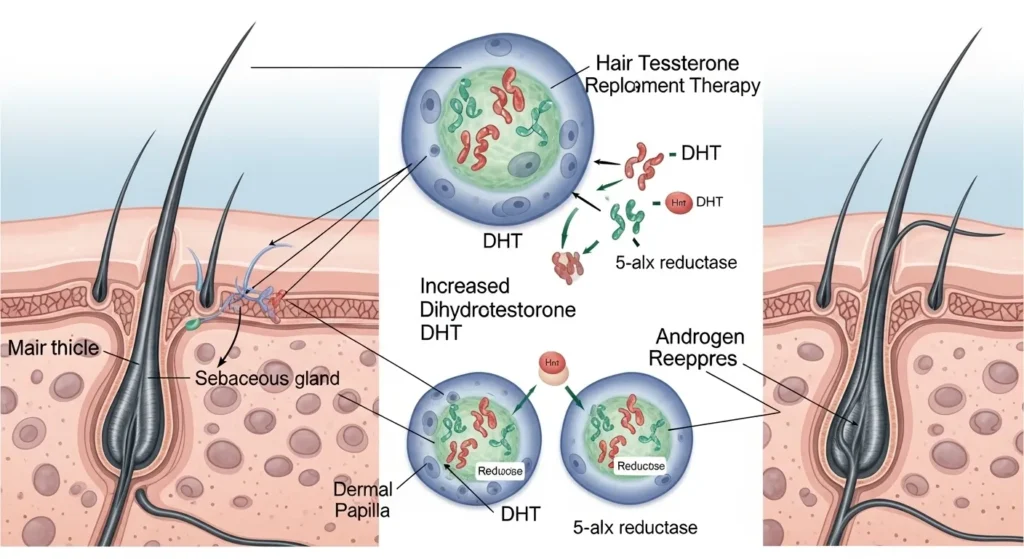Worried the is TRT hair loss reversible or permanent? Testosterone replacement therapy (TRT) can help with energy, muscle mass, and mood, but for some, it accelerates hair thinning.
In this guide, we’ll explore whether TRT-related hair loss can be stopped or reversed, the best prevention strategies, and how long recovery might take.
With insights from medical research, expert advice, and real patient experiences, you’ll learn how to protect your hair while benefiting from TRT — confidently and with the right plan.
What Causes Hair Loss During TRT?

TRT itself doesn’t “create” new hair loss in everyone, but it can speed up the process in those genetically predisposed to male or female pattern baldness.
Role of DHT Conversion & Genetic Sensitivity
- When you take testosterone (naturally or through TRT), a portion converts into dihydrotestosterone (DHT) via the 5-alpha reductase enzyme.
- DHT binds to hair follicle receptors, shrinking them over time and shortening the growth phase (anagen).
- People with androgen-sensitive hair follicles (inherited from their family) are most affected.
When Low Testosterone vs. High DHT Is the Culprit
If you were already losing hair before TRT, it may simply accelerate an existing process.
Low testosterone before TRT may cause hair shedding indirectly (via stress, nutrient deficiencies, or hormonal imbalances).
Once TRT raises testosterone, DHT spikes may cause sudden shedding, especially in the crown and hairline.
Is TRT Hair Loss Reversible?
The answer is sometimes yes, no, depending on follicle health, duration of loss, and treatment response.
- Reversible cases:
If follicles are still alive (miniaturized but active), reducing DHT or stopping TRT can allow them to recover. - Permanent cases:
If follicles are completely miniaturized and dormant for years, regrowth is unlikely without surgical help.
Cases Where Stopping TRT May Lead to Regrowth
- Some patients report regrowth within 3–6 months after stopping TRT when combined with DHT blockers or regrowth treatments.
- Shedding often slows within a few weeks once DHT levels drop.
Pro Tip: If hair loss started only after TRT and you stop early, chances of partial regrowth are higher.
Instances Where Damage Is Permanent
- Long-term miniaturization (over several years) can result in irreversible loss.
- Genetics still play a role — even stopping TRT won’t reverse androgenetic alopecia if it’s strongly inherited.
Preventive and Restorative Treatments
Finasteride & Dutasteride – DHT Inhibitors
- Finasteride blocks ~70% of DHT; dutasteride blocks up to 90%.
- Often prescribed alongside TRT to protect hair follicles.
- Must be monitored for side effects such as decreased libido or mood changes.
- Best for: Those with a strong family history of pattern baldness starting TRT.
Minoxidil, LLLT, PRP — Evidence-Based Options
- Minoxidil (topical/oral): Increases blood flow, prolongs the anagen phase.
- Low-Level Laser Therapy (LLLT): Stimulates follicles and reduces inflammation.
- Platelet-Rich Plasma (PRP): Concentrated growth factors are injected into the scalp.
Natural Adjuncts
- Caffeine shampoos — mild DHT-blocking effect.
- Saw palmetto supplements — plant-based 5-alpha reductase inhibition.
- Supportive only; results are usually modest.
Surgical Options — Hair Transplantation
- Follicular Unit Extraction (FUE) or FUT can restore hair in permanent loss zones.
- Works even if the patient continues TRT, but long-term DHT management is recommended.

Recovery Timeline & What to Expect
Shedding After Cessation or Starting Treatment
- Initial shedding (“shock loss”) is common when starting finasteride or minoxidil, as follicles transition to the regrowth phase.
- It may also occur in the first months of TRT as hormones stabilize.
Timeline for Seeing Regrowth
- 0–3 months: Shedding slows; follicles prepare for new growth.
- 3–6 months: Early signs of regrowth in thin areas.
- 6–12 months: Noticeable density improvement with consistent treatment.
FAQs
Is all hair loss from TRT permanent?
No — if follicles are still viable, targeted treatment can restore density.
Can stopping TRT reverse hair thinning?
It may, especially if hair loss is recent. Long-standing baldness is less reversible.
How soon should I start protective treatments?
Before or at the very start of TRT for best results.
What are the safest options while on TRT?
Finasteride, minoxidil, and lifestyle support under medical guidance.
Will a hair transplant work if I’m still on TRT?
Yes, but managing DHT levels is crucial for preserving native hair.
Next Steps
If you’re concerned about hair thinning while on testosterone therapy, early action is key. The sooner you address follicle health, the better your chances for reversal.
Book a consultation with Dr. Rana Irfan in Islamabad to discuss personalized strategies for preserving and restoring your hair while benefiting from TRT.
Our team combines advanced hair loss treatments, hormonal guidance, and long-term monitoring to ensure your hair and your confidence stay strong.
